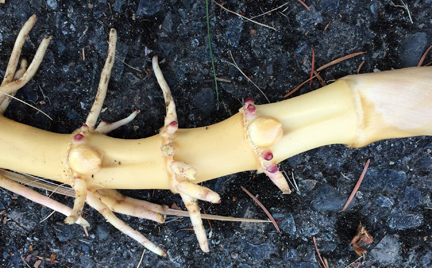Removing Bamboo
If you would like to remove your bamboo yourself, please consider a consult to make the job much more successful. Here is a link to our Consulting Service.
Otherwise ,remember the key point, whatever you do to the above ground portions of the plant will change the behavior of the underground, regenerative portions.
It looks like poison works as the leaves, branches, and canes above ground die. Meanwhile, the rhizome that grew the cane will have started 2-4 more canes, or traveled another 1o feet into yours or neighboring properties.
It may feel real good to cut the grove down to the ground in a few hours. Hauling and disposing, loading and unloading is also reuired and will take as long. Here is a hint: do not wait until the canes are dried out brittle to haul them, this job should be done as soon as possible.
You may cut down a few hundred canes 1" in diameter and in a few weeks there will have grown a few thousand canes 1/4" in diameter throughout the area. Now you have information as to where the rhizomes are under the ground (all over!), but you have done nothing to rid yourself of the bamboo.
We would love for you to remove your own bamboo, but when that is not popssible, we would love to help you.
Bamboo removal is a labor intensive process that involves the removal of the visible plants and all rhizomes under the soil. Reasons for removal usually involve stands or groves that were not planted correctly, where a barrier has failed, where the bamboo has not been maintained, the plant is dying or not doing well, or the plant has become invasive to neighbors or other areas of your garden.
There are some difficulties with bamboo removal like the weight of the culms and root balls is considerable, the tools that are necessary for proper removal are expensive, sharp, and usually heavy and awkward. Some home removal efforts result in future problems that can be quite difficult to mitigate. Please email if you have any questions.
Once a grove is "attacked" it will "fight back" - the plant has a strong survival instinct.
We use what many call a bamboo slammer, heavy shovels, and heavy bars. If there is evidence of prior work done to kill or smother the bamboo we may even have to use heavy equipment, though the soil must be sifted by hand following this process.
Smothering bamboo, poisoning it, trying to starve it, bury it, or dry it out DOES NOT work.
Bamboo is a hearty, robust plant and can send shoots to find water and nutrients in other places on your and your neighbor's property. There is a tremendous amount of energy stored in the rhizomes, and bamboo is able to photosynthesize with a minimum of light.
Frustrated neighbors have been known to sue for damage to their property from bamboo rhizomes that have traveled onto their property.
It is important to have Washington State licensed, bonded, and insured workers remove bamboo, just like any other professional service.
Removed bamboo can be potted or transplanted successfully if removed correctly at the right time of the year. Most other times will yield some good results. We shred discarded culms and leaves for compost and mulch. We often donate our bamboo to the Woodland Park Zoo for habitat and to feed the rhinos, orangs, and gorillas.
There is only one way to extricate the plant from your porperty and that is to dig out every rhizome under the ground.

The regenerative portion of the plant - the invincible rhizome.
Seattle Bamboo Information
Seattle Bamboo is licensed by the State of Washington, bonded to assure the work gets done as agreed, and fully insured to work on your property. Our state license number is SEATTB*913ML
We provide free estimates via email based on images and measurements provided by property owners. If an onsite consult is required we charge a fee for this service: Consulting
Seattle Bamboo Contact Information
Email us at bruce@seattlebamboo.com
Or call us at 206.724.1977
We answer bamboo questions with honest answers, not answers that promote our business.
